You’re directly contributing to marine ecosystem destruction when you purchase coral jewelry, as the industry’s demand drives harmful harvesting practices that damage essential reef habitats. Coral bleaching weakens these ecosystems while commercial pressures intensify harvesting, threatening the 25% of marine species that depend on reefs. Though CITES regulations attempt to control trade, enforcement gaps persist, and artificial bleaching techniques further compromise coral’s natural integrity. Understanding sustainable alternatives and legal frameworks can guide your purchasing decisions toward more responsible choices.
Understanding Coral Bleaching Processes and Techniques
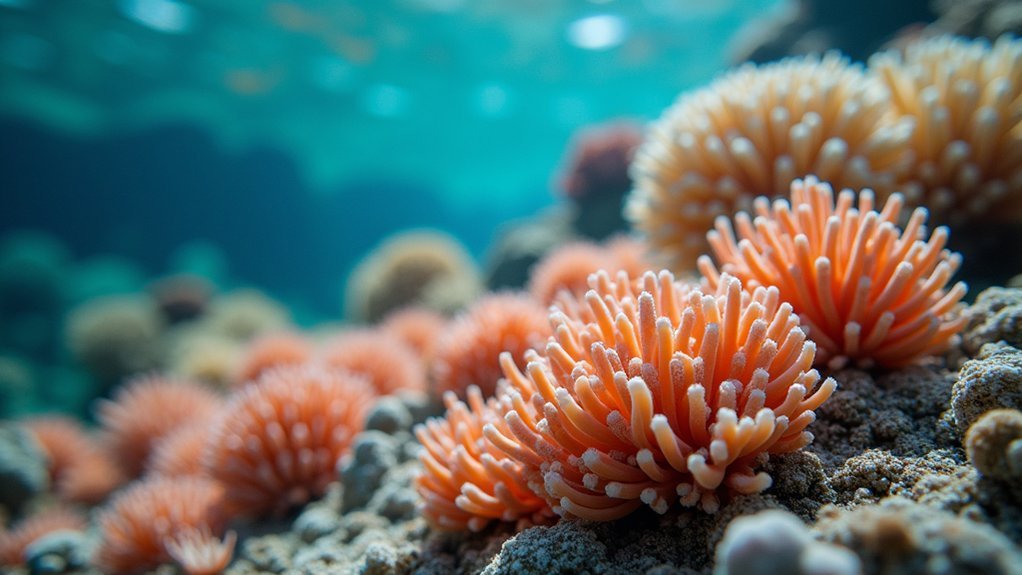
When water temperatures rise beyond their tolerance threshold, corals undergo a defensive mechanism called bleaching that dramatically transforms their appearance and threatens their survival.
You’ll observe corals expelling their symbiotic zooxanthellae algae, losing both vibrant colors and essential nutrients. This coral bleaching process weakens the organisms, making them susceptible to disease and death if temperatures don’t stabilize quickly.
Understanding these natural processes reveals significant ethical issues when you consider coral harvesting for jewelry.
You’re witnessing ecosystems already stressed by climate change facing additional pressure from commercial extraction. The techniques used to bleach coral for jewelry further damage these vulnerable organisms.
You can’t ignore that coral bleaching events now occur more frequently, with recovery taking decades.
Your purchasing decisions directly impact marine biodiversity and communities dependent on healthy reef ecosystems for survival.
Environmental Impact of Coral Harvesting for Jewelry
When you purchase coral jewelry, you’re directly contributing to ecosystem destruction that threatens marine biodiversity on a global scale.
Your demand drives harvesting practices that damage Mediterranean and other coral reefs, which grow at an impossibly slow rate of just one millimeter per year.
You can make a difference by understanding how sustainable harvesting practices offer alternatives that protect these critical underwater ecosystems.
Ecosystem Destruction and Damage
Although coral jewelry has adorned humans for centuries, the harvesting practices required to create these decorative pieces are systematically destroying marine ecosystems at an alarming rate.
When you consider coral harvesting methods, you’re witnessing ecosystem destruction that extends far beyond individual coral colonies. Traditional fishing techniques using scuba diving and nets physically damage entire reef structures, creating widespread habitat loss that affects countless marine species.
You’ll find that this destruction triggers cascading effects throughout ocean environments. As harvesting disrupts the intricate balance of marine ecosystems, you’re seeing biodiversity collapse and critical ecosystem services disappear.
Coral reefs provide essential coastal protection and nursery habitats, but overharvesting eliminates these benefits. The slow growth rate of precious corals—just one millimeter annually—means you’re watching irreversible damage unfold across generations.
Sustainable Harvesting Practices
While the damage from traditional coral harvesting appears devastating, you can find hope in emerging sustainable harvesting practices that protect marine ecosystems while preserving cultural traditions. These environmental and ethical approaches include strict regulations on coral fishing with size limits, quotas, and designated harvesting areas.
| Practice | Method | Impact |
|---|---|---|
| Regulated Diving | Scuba instead of destructive nets | Preserves coral beds |
| Size Limits | Minimum coral dimensions | Protects young colonies |
| Quota Systems | Annual harvest caps | Prevents overexploitation |
| Protected Zones | No-fishing areas | Maintains breeding populations |
Mediterranean coral beds exemplify successful recovery through these sustainable harvesting practices. However, precious coral’s 1-millimeter annual growth rate makes commercial farming unviable, emphasizing why you must support responsible harvesting over cultivation alternatives.
The Distinction Between Natural and Artificially Bleached Coral
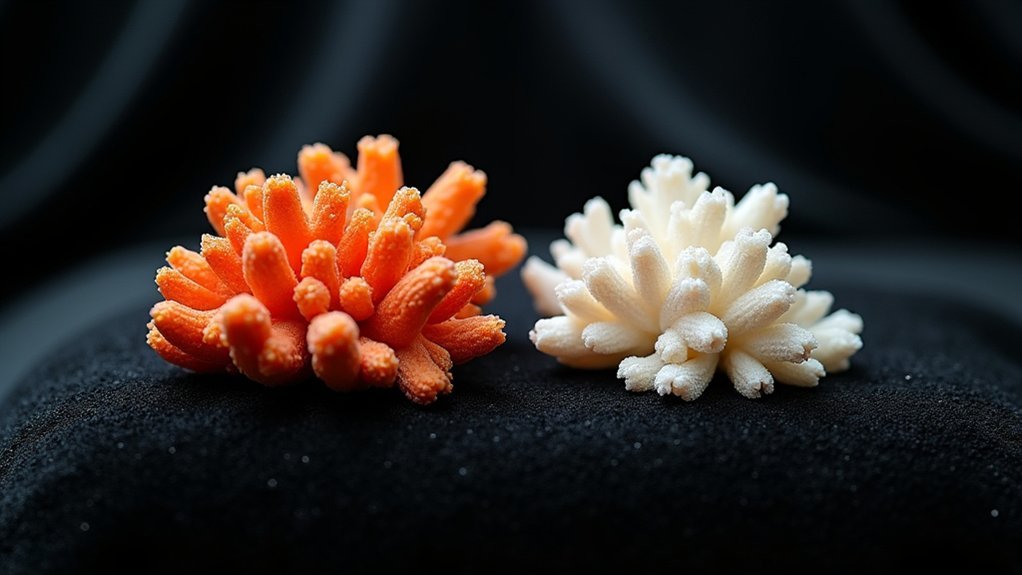
You’ll notice that natural coral develops its distinctive colors through biological processes over time, creating the unique patterns and hues that make each piece authentic.
When manufacturers artificially bleach coral, they’re using chemical treatments that strip away or alter these organic characteristics to achieve brighter, more uniform appearances.
You can identify these treatment methods by examining the coral’s surface texture and color consistency under magnification.
Natural Coral Color Formation
Nature’s artistry in coral color formation stems from carotenoid pigments and the coral’s unique structural properties, creating the coveted salmon pink to deep red hues that penetrate uniformly throughout genuine specimens.
When you’re examining natural coral, you’ll notice these colors develop organically as the precious coral grows at its remarkably slow rate of just one millimeter annually.
The genus Corallium produces these authentic colorations through biological processes that can’t be replicated artificially.
You’ll find that genuine specimens display consistent pigmentation from surface to core, reflecting years of natural development.
- Carotenoid pigments create authentic salmon pink to deep red coloration
- Natural coral grows slowly at 1mm per year, developing uniform colors
- Precious coral from Corallium genus exhibits consistent pigmentation throughout
- Genuine specimens show biological patterns absent in treated materials
Artificial Bleaching Chemical Processes
Chemical bleaching processes fundamentally alter coral’s authentic characteristics, creating specimens that bear little resemblance to their natural counterparts despite initial visual appeal.
When you examine artificially bleached coral, you’ll notice the telltale uniform appearance that lacks natural variations. Manufacturers typically use hydrogen peroxide and other harsh bleaching agents that strip away the coral’s original properties and structural integrity.
This artificial bleaching raises significant ethical concerns since you might unknowingly purchase what appears to be genuine coral. Unlike natural specimens with their unique biological patterns and color gradients, chemically treated coral displays a homogeneous look that’s detectable under magnification.
These chemical processes don’t just deceive consumers—they create harmful waste products that threaten marine ecosystems already struggling with overharvesting and pollution.
Identifying Treatment Methods
When examining coral jewelry, distinguishing between natural and artificially bleached specimens requires careful attention to several key characteristics that reveal their true origins.
You’ll notice that natural coral used in jewelry displays consistent coloration throughout, while artificially bleached coral often shows stark contrasts or inconsistencies that reveal chemical treatment.
The texture and hardness also differ greatly between treated and untreated pieces.
- Examine color patterns – Natural coral maintains uniform hues, while treated pieces show uneven bleaching or artificial dye deposits
- Check surface structure – Look for preserved concentric rings and tiny canals that chemicals can alter or obscure
- Test hardness levels – Genuine coral registers 3.5-4 on the Mohs scale with consistent texture
- Request documentation – Reputable dealers provide sourcing information and treatment disclosure
Legal Regulations Governing Coral Trade and Treatment
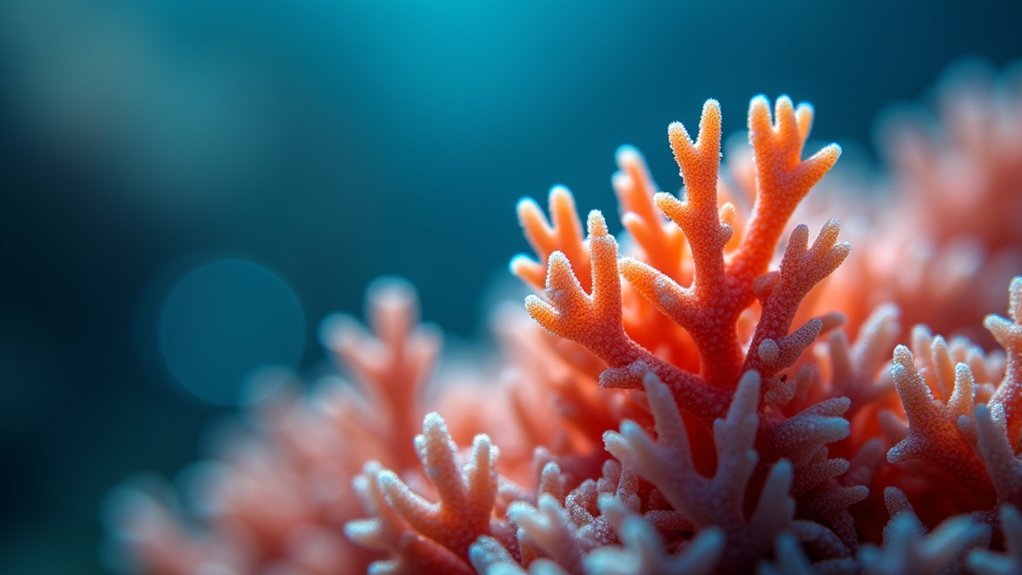
Although coral’s natural beauty makes it highly sought after for jewelry, you’ll find that harvesting and trading these marine organisms is heavily regulated by international and national laws. The Convention on International Trade in Endangered Species (CITES) classifies coral species under various appendices, controlling their commercial use in coral jewelry markets worldwide.
| Regulation Type | Coverage |
|---|---|
| CITES International | Controls Trade in Endangered Species |
| Regional Laws | Varies by country/location |
| Mediterranean Protection | Red coral restrictions |
| Enforcement Challenges | Identifying legal sources |
You’ll encounter different legal frameworks depending on your location. Some countries permit coral jewelry from specimens washed ashore, while others ban all coral possession entirely. Mediterranean red coral faces particularly strict protection due to depletion. Despite existing regulations, enforcement remains challenging because distinguishing legal from illegal coral sources proves difficult for authorities and consumers alike.
CITES Guidelines and International Coral Protection Laws
Since its establishment in 1975, CITES has created a three-tiered appendix system that directly affects your ability to purchase and own coral jewelry.
Mediterranean red coral falls under Appendix II, requiring controlled trade to prevent overexploitation. These CITES guidelines aim to balance commercial interests with conservation needs, but enforcement varies dramatically between countries.
When you’re shopping for coral in jewelry, you’ll encounter these regulatory challenges:
- Permit requirements – Legal coral jewelry must include proper documentation proving sustainable sourcing
- Species identification – You need to verify which coral species you’re purchasing to guarantee compliance
- Import restrictions – Your country may have additional laws beyond basic CITES guidelines
- Enforcement gaps – Illegal coral trade persists due to inconsistent international enforcement efforts
Sustainable Alternatives to Traditional Coral Sourcing
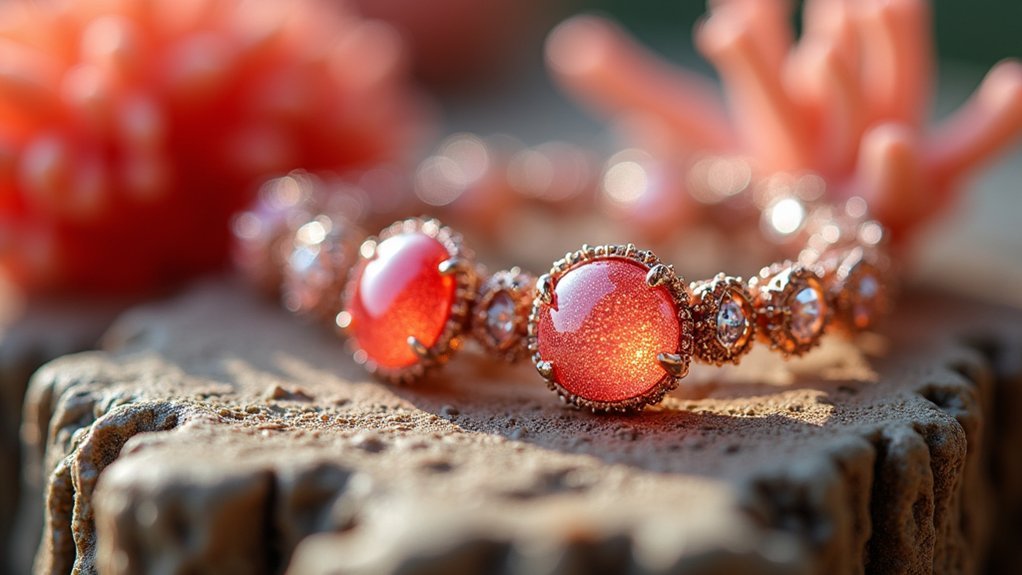
The complexities of coral regulation have sparked innovation in the jewelry industry, leading manufacturers to develop sustainable alternatives that eliminate legal uncertainties while protecting marine ecosystems. You’ll find synthetic coral replicating natural coral’s aesthetic qualities without environmental harm. Dyed bamboo coral and lab-grown calcium carbonate offer eco-friendly substitutes with vibrant colors while reducing pressure on precious coral populations.
| Material Type | Environmental Impact | Aesthetic Quality |
|---|---|---|
| Synthetic Coral | Zero ecosystem damage | High replication |
| Bamboo Coral | Renewable resource | Excellent dyeability |
| Lab-grown Materials | Minimal carbon footprint | Customizable properties |
You can explore antique coral jewelry for ethical options or choose porcelain and glass alternatives that mimic coral’s appearance. This rising awareness of coral’s ecological importance drives the industry toward responsible sourcing practices.
Consumer Responsibility in Coral Jewelry Purchasing Decisions
You hold significant power in protecting coral reefs through your jewelry purchasing choices.
When you’re shopping for coral pieces, you’ll need to verify the source’s legitimacy, understand legal regulations, and explore sustainable alternatives that don’t harm marine ecosystems.
Your informed decisions can either support destructive harvesting practices or promote ethical alternatives that preserve these essential underwater habitats.
Sourcing Verification Methods
When purchasing coral jewelry, you’ll need to verify sourcing through proper documentation that proves legal origin and compliance with CITES regulations for protected species.
These sourcing verification methods guarantee you’re supporting ethical standards while protecting marine ecosystems.
You should distinguish between natural coral and imitation materials, as many products marketed as coral are actually dyed bamboo or synthetic alternatives.
Research your jeweler’s transparency regarding harvesting practices and environmental impact assessments.
Consider these verification approaches:
- Request official documentation showing legal harvesting permits and CITES compliance certificates
- Ask jewelers about their coral species’ growth rates and sustainability practices
- Research the reputation of suppliers and their commitment to ethical sourcing
- Explore antique or vintage coral pieces to reduce pressure on living populations
Legal Compliance Awareness
Beyond sourcing verification lies your fundamental responsibility to understand and follow legal requirements governing coral jewelry purchases.
You must recognize that CITES regulates certain coral species, restricting their trade to protect endangered populations from illegal harvesting. Local laws vary dramatically—some regions completely ban coral trade while others allow regulated sales.
Legal compliance requires you to verify purchase legality in your specific location before buying. You’ll need proper documentation certifying the coral’s origin and legal status. Reputable dealers provide this certification, while its absence often signals illicit practices.
Your awareness of environmental impacts should guide you toward sustainable choices.
Consider vintage or antique coral jewelry instead of newly harvested pieces. This approach supports conservation while maintaining legal compliance and ethical purchasing standards.
Sustainable Alternative Options
Although natural coral jewelry maintains traditional appeal, sustainable alternatives offer environmentally conscious choices that don’t compromise aesthetic beauty.
You’ll discover eco-friendly options like synthetic coral, glass, and porcelain that replicate natural coral’s vibrant colors and textures without harming reef ecosystems. When you do choose natural coral, seek suppliers who follow sustainable harvesting practices to minimize environmental damage.
Consider these responsible alternatives:
- Purchase antique or vintage coral jewelry to reduce demand for newly harvested materials
- Select synthetic coral made from glass or porcelain for guilt-free beauty
- Research suppliers’ commitment to sustainable harvesting practices before buying
- Explore coral-inspired designs using alternative materials that mimic natural appearances
You’re empowered to make informed decisions that protect marine environments while still enjoying coral’s aesthetic appeal through thoughtful purchasing choices.
Industry Standards for Ethical Coral Treatment Practices
As the jewelry industry grapples with mounting environmental concerns, extensive standards for ethical coral treatment have emerged to guide responsible sourcing practices. You’ll find that CITES monitoring prevents illegal harvesting while promoting sustainable trade of coral species. Industry leaders now prioritize transparency, requiring documentation that verifies legal origins of coral reefs used in products.
| Standard | Requirement | Impact |
|---|---|---|
| CITES Monitoring | Trade documentation | Prevents illegal harvesting |
| Sustainable Sourcing | Managed fishery verification | Protects coral populations |
| Vintage Usage | Antique coral pieces | Reduces current environmental impact |
| Transparency | Origin documentation | Guarantees legal compliance |
| Alternative Materials | Sustainable substitutes | Eliminates coral reef dependency |
Major retailers have shifted away from Coral Jewellery entirely, embracing sustainable alternatives that protect fragile marine ecosystems while maintaining aesthetic appeal.
The Role of Certification in Coral Jewelry Authentication
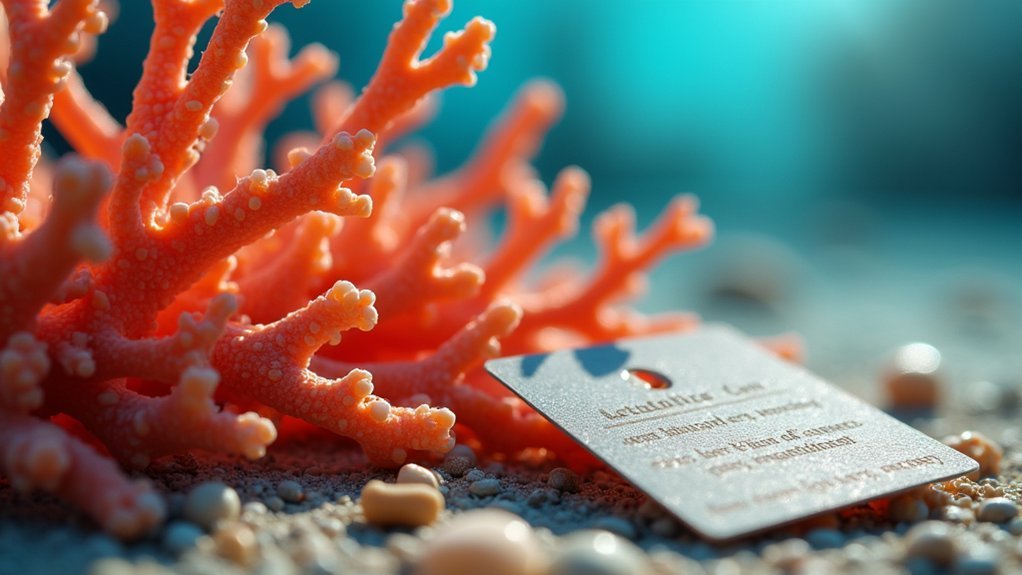
Authentication certificates serve as your primary defense against fraudulent coral jewelry in today’s complex marketplace. When you’re purchasing coral pieces, certification guarantees you’re buying legally sourced, sustainable materials that comply with CITES regulations.
These documents verify the authenticity and provenance of your coral jewelry, protecting you from imitation or illegally harvested specimens.
Reputable jewelers and gemmological institutes provide extensive certification services that assess quality and ethical sourcing standards. You’ll find that certified pieces command higher values because they guarantee authenticity in a market flooded with dyed and synthetic alternatives.
Certified coral jewelry guarantees authenticity and commands premium prices in markets saturated with synthetic and artificially enhanced alternatives.
- Verify compliance with international trade regulations for endangered coral species
- Confirm authentic materials versus imitation or synthetic substitutes
- Guarantee sustainable sourcing practices preventing illegal poaching
- Enhance resale value through documented provenance and quality assessment
Economic Pressures Driving Coral Bleaching Demand
While certification protects buyers from fraudulent pieces, the economic forces behind coral jewelry create devastating pressures on marine ecosystems.
You’re witnessing prices skyrocket as natural coral becomes thousands of percent more valuable due to rarity. This creates irresistible incentives for illegal coral harvesting, with poachers prioritizing immediate profits over long-term sustainability.
The luxury jewelry market’s demand for Mediterranean precious coral drives unsustainable practices that directly harm coral ecosystems.
When you purchase coral jewelry, you’re participating in a market where economic pressures often overshadow conservation efforts.
Artisans and businesses face financial pressure to meet demand, leading to overexploitation that contributes to coral bleaching.
The industry’s focus on immediate economic gain compromises the health of coral reefs worldwide.
Marine Ecosystem Preservation Versus Commercial Interests
These economic pressures create a direct conflict between protecting marine ecosystems and satisfying commercial demands.
You’re witnessing a critical battleground where coral bleaching weakens reefs just as commercial interests intensify harvesting pressure. When bleached corals become vulnerable, they can’t withstand additional stress from jewelry industry exploitation.
You’ll find that preserving 25% of marine species depends on maintaining healthy coral populations, yet commercial interests often prioritize short-term profits over long-term sustainability.
This creates an ethical paradox where consumer demand directly threatens the ecosystems that produce the very materials being sought.
- CITES regulations attempt to balance conservation with trade, but enforcement gaps persist
- Coral bleaching reduces reef resilience against commercial harvesting pressures
- Alternative materials offer sustainable solutions for jewelry manufacturers
- Consumer education drives demand for ethically-sourced marine products
Synthetic and Lab-Created Coral Substitutes
You’ll find that synthetic coral substitutes emerge through controlled laboratory processes that replicate natural coral’s calcium carbonate structure using sustainable materials.
These lab-created alternatives dramatically reduce environmental damage by eliminating the need to harvest from vulnerable marine ecosystems.
You’re supporting ocean conservation while maintaining coral jewelry’s aesthetic appeal when you choose these eco-friendly substitutes.
Manufacturing Process Overview
As environmental concerns drive innovation in jewelry manufacturing, synthetic coral substitutes have emerged through sophisticated production methods that replicate nature’s intricate designs.
You’ll find manufacturers using advanced molding techniques with resin, plastic, and glass materials to create stunning coral-like pieces. Lab-created alternatives employ cutting-edge processes that mimic calcium carbonate formation, producing biologically accurate structures.
When you choose synthetic coral, you’re supporting marine conservation while enjoying controlled quality and consistent coloring. Unlike natural coral’s unpredictable variations, manufacturers can precisely engineer each piece’s appearance and characteristics.
- Molding techniques: Resin and plastic materials shaped into coral-like forms
- Calcium carbonate replication: Advanced lab processes mimicking natural coral formation
- Quality control: Consistent color and texture unlike variable natural specimens
- Environmental impact: Reduces wild coral harvesting pressure
Environmental Impact Benefits
While natural coral reefs face unprecedented threats from climate change and human activity, synthetic coral substitutes offer a powerful solution that protects these fragile ecosystems from further exploitation.
When you choose lab-created alternatives, you’re directly reducing demand for harvested coral that damages critical marine habitats. These eco-friendly materials deliver the same aesthetic appeal without contributing to coral bleaching or reef destruction.
You’ll find that synthetic coral production eliminates illegal poaching while supporting marine biodiversity conservation. The manufacturing process creates recyclable materials that promote a circular economy, reducing virgin resource consumption.
Vintage and Antique Coral Jewelry as Ethical Options
When you’re searching for coral jewelry that aligns with your environmental values, vintage coral and antique pieces offer an elegant solution that doesn’t contribute to current coral harvesting pressures.
These historical treasures showcase exceptional craftsmanship while protecting marine eco-systems from further exploitation.
Vintage coral treasures blend artisanal mastery with environmental responsibility, preserving ocean habitats through conscious collecting choices.
You’ll find vintage coral pieces particularly valuable because they:
- Utilize existing materials harvested before modern environmental regulations
- Appreciate notably in value due to historical significance and unique craftsmanship
- Support circular economy principles by reusing beautiful materials
- Showcase distinctive designs reflecting past cultural styles and techniques
Future Outlook for Responsible Coral Jewelry Production
Beyond choosing vintage pieces, the jewelry industry itself is undergoing a fundamental shift toward environmentally conscious practices that will reshape how coral appears in fine jewelry.
You’ll witness major jewelers liquidating their coral inventory while donating proceeds to marine conservation efforts. This illustrates genuine commitment to protecting vulnerable ecosystems.
Synthetic alternatives are becoming the new standard, offering coral’s aesthetic appeal without environmental harm. You can expect continued price increases for natural coral as scarcity drives market dynamics.
Educational initiatives will empower you to make informed decisions about coral jewelry purchases. The industry’s future prioritizes sustainability over tradition, ensuring that coral’s beauty in jewelry doesn’t compromise our oceans’ health.
Frequently Asked Questions
Is It Ethical to Wear Coral Jewelry?
You shouldn’t wear newly-made coral jewelry since it harms slow-growing coral populations and marine ecosystems. However, you can ethically choose vintage or antique coral pieces that don’t contribute to current harvesting pressures.
What Are the Arguments for Coral Bleaching?
You’d find arguments claiming coral bleaching creates research opportunities for marine adaptation studies, potentially leads to stronger coral species through natural selection, and might reveal resilient reef systems that’ll survive climate change.
Is It Okay to Buy Coral Jewelry?
You shouldn’t buy new coral jewelry since it fuels overharvesting of slow-growing corals that take decades to mature. Instead, you can choose vintage pieces or sustainable alternatives that don’t harm living reefs.
Is Coral Jewellery Legal?
Coral jewelry’s legality depends on your location and the coral’s origin. You’ll need proper documentation proving legal sourcing, as many species are CITES-protected. Antique pieces are generally safer than newly harvested coral.
In Summary
You’ll need to make conscious choices when purchasing coral jewelry. You can’t ignore the environmental impact of harvesting practices that damage marine ecosystems. You should prioritize vintage pieces, lab-created alternatives, or guarantee you’re buying from suppliers who follow CITES regulations. You’re supporting either conservation or destruction with your purchase decisions. You’ll help preserve coral reefs by choosing synthetic substitutes or ethically sourced vintage coral jewelry instead of newly harvested pieces.

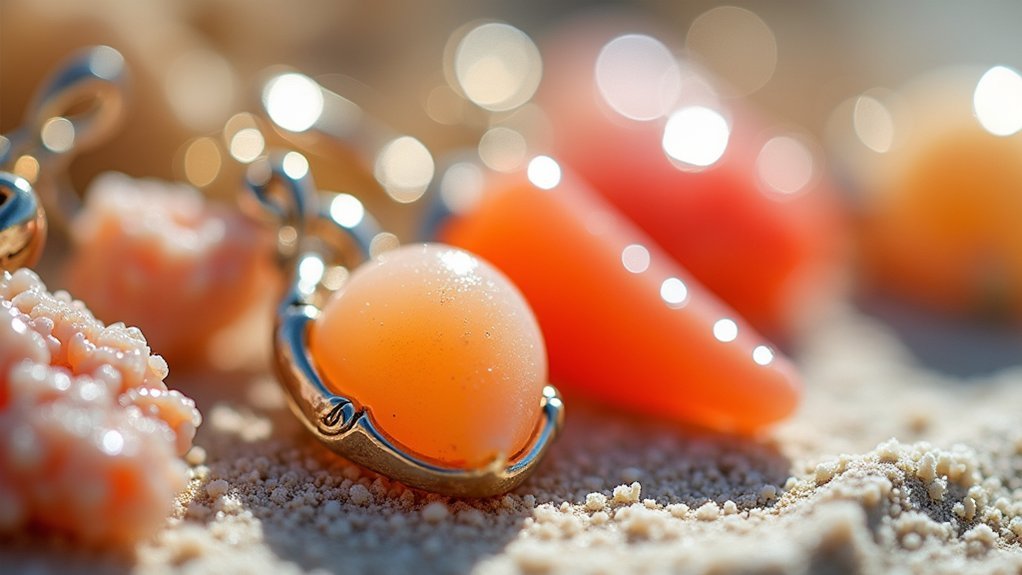
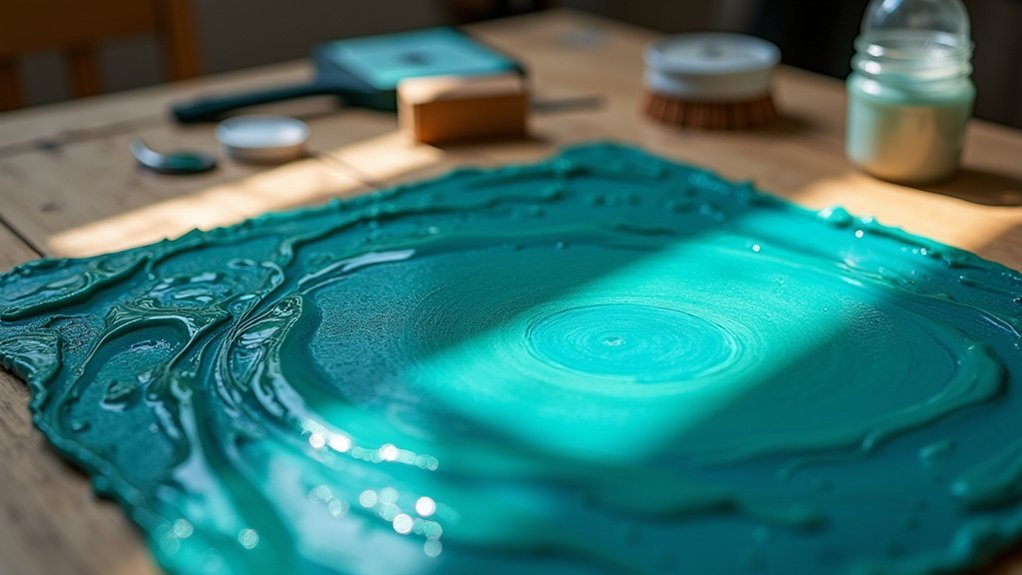
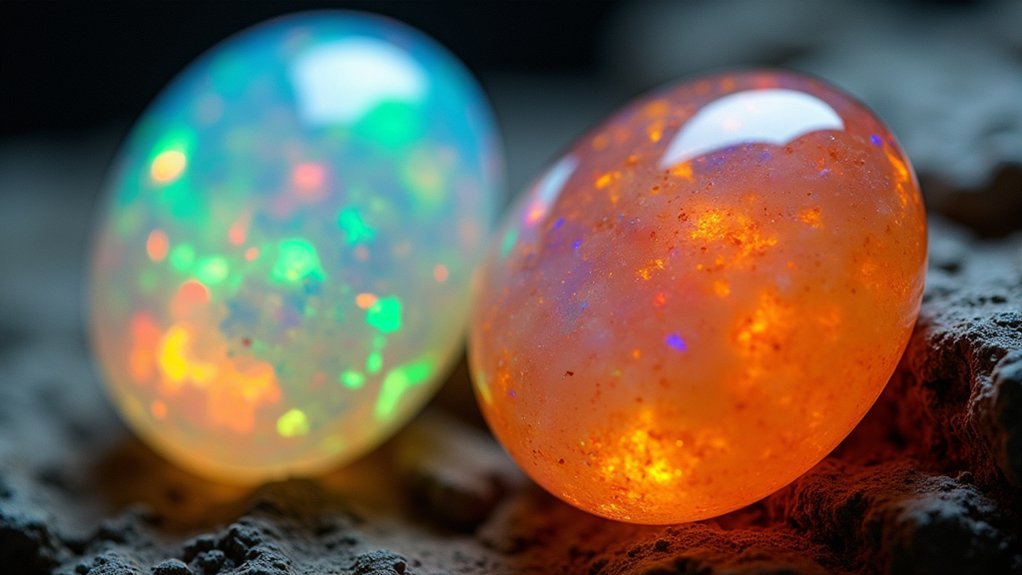
Leave a Reply